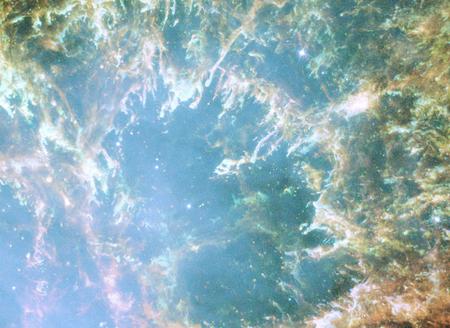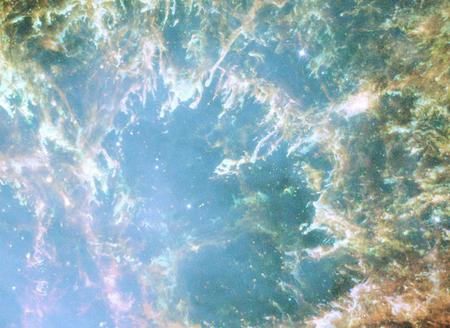Astronomers find solar storms behave like supernovae

Researchers at the UCL studying details of Coronal Mass Ejections (CMEs) have noticed that those eruptions have a surprising twin in the depths of space: the tendrils of gas in the Crab Nebula, which lie 6500 light-years away and are millions of times larger.
On June 7, 2011, the biggest ejection of material ever observed erupted from the surface of the Sun. Over the days that followed, the plasma belched out by the Sun made its way out into space. But most of the material propelled up from the Sun’s surface quickly fell back towards our star’s surface.
For the solar physicists at UCL’s Mullard Space Science Laboratory, watching these solar fireworks was a unique opportunity to study how solar plasma behaves.
“We’ve known for a long time that the Sun has a magnetic field, like the Earth does. But in places it’s far too weak for us to measure, unless we have something falling through it. The blobs of plasma that rained down from this beautiful explosion were the gift we’d been waiting for”, says David Williams, one of the study’s authors.

The June 7, 2011 solar storm, seen by the Solar Dynamics Observatory. Credit: NASA/SDO (Helioviewer)
That eruption was by some margin the biggest recorded since this constant monitoring began, meaning the huge cascade of matter that fell back into the Sun following the eruption was a unique opportunity to study, on an unusually large scale, the fluid dynamics of these phenomena.
“We noticed that the shape of the plume of plasma was quite particular,” says Jack Carlyle, lead author of the study. “As it fell into the Sun, it repeatedly split apart like drops of ink falling through water, with fingers of material branching out. It didn’t stick together. It’s a great example of an effect where light and heavy fluids mix.”
Less dense materials typically float on top of denser ones without mixing together, for example oil sitting on water, or layers of different liqueurs in a cocktail. Change the order by putting the denser fluid on top, however, and the denser one will quickly fall through the less-dense one until their positions are reversed. The complex pattern formed by the denser fluid as it repeatedly splits and branches into ever-finer ‘fingers’ of matter, is caused by a phenomenon known as the Rayleigh-Taylor instability.


Hubble Space Telescope images of the Crab Nebula show similar branching finger-like structures. Image credit: NASA, ESA, Alison Loll & Jeff Hester
The team noticed in SDO’s high-resolution images that the falling plasma clearly underwent the Rayleigh-Taylor instability as it returned to the Sun’s surface. This is as would be expected – the solar plasma is denser than the solar atmosphere it is falling through. In space, a similar effect has been observed before, albeit on a much larger scale, in the Crab Nebula.
The Crab Nebula is the remnant of a supernova which exploded in the 10th century. In the millennium that has followed the explosion, denser matter has started to fall back into the centre of the nebula, exhibiting the same finger-like structures as the team observed in the Sun.
A major study of the Crab Nebula in 1996 found that the Rayleigh-Taylor instability in the Crab Nebula was actually slightly modified. The highly magnetised environment in the nebula changes the proportions of the fingers, making them fatter than they would be otherwise.
The UCL team found that the same effect was going on in the June 7, 2011 CME: even in an area where the Sun’s magnetic field was weak, it was modifying the Rayleigh-Taylor effect, changing the shape of the plume of plasma as it fell back into the Sun.


Source: UCL Faculty of Mathematical and Physical Sciences
Reference:
- "Investigating the dynamics and density evolution of returning plasma blobs from the 2011 June 7 eruption" – Jack Carlyle, David R. Williams, Lidia van Driel-Gesztelyi, Davina Innes, Andrew Hillier, Sarah Matthews . arXiv:1401.4824v1 [astro-ph.SR]
Featured image: Hubble Space Telescope images of the Crab Nebula show similar branching finger-like structures. Image credit: NASA, ESA, Alison Loll & Jeff Hester

"As above, so below."